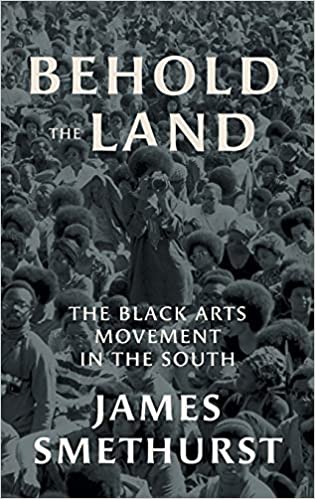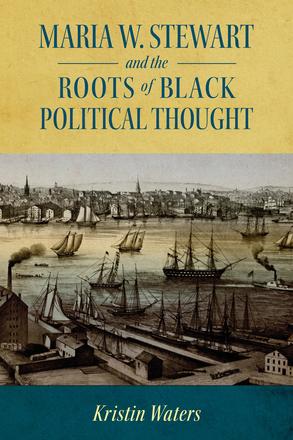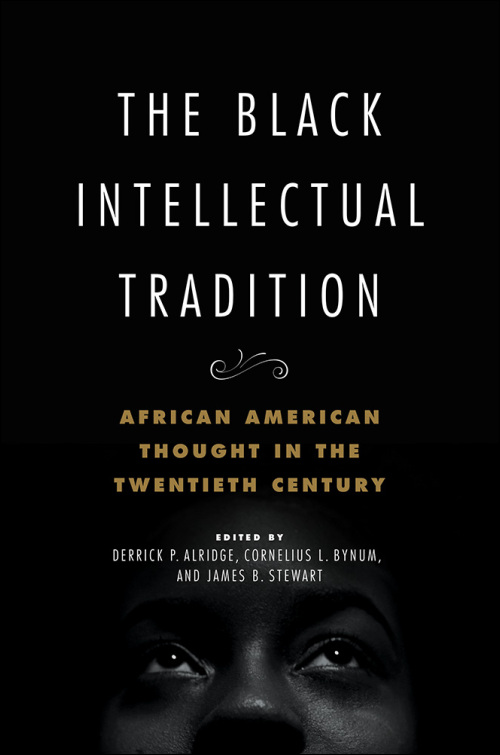The Book
The Black Intellectual Tradition, Behold the Land, and Maria W. Stewart and the Roots of Black Political Thought
The Author(s)
Derrick P. Alridge et. al., James Smethurst, and Kristin Waters

In a signal moment in Behold the Land, his account of the rise of Black Arts in the South, James Smethurst describes the improvisational work required of actors at the Free Southern Theater performing before rural audiences who might, at any point, tire of watching, and instead “actively respond” to the play by calling out to the actors or, as one man did, walking onto the stage and remaining there for the rest of the performance (68). While a staple of avant-garde theater of the era, the collapse of boundaries between stage and world resonates differently among those who may not have known or cared how to “do theater” but who nevertheless understood its power and their own power to make it relevant to their lives. This includes Beckett’s Waiting for Godot, one of the troupe’s early productions, whose central themes were not lost on those accustomed to waiting for something that never happens.
When they first proposed the Free Southern Theater in 1964, its founders said their “fundamental objective” was “to stimulate creative and reflective thought among Negroes” in order to promote greater self-knowledge and, consequently, political change.[1] As the “cultural and educational dimension to the Southern freedom movement,” they argued, theater would be the artistic equivalent to voter registration, community centers, and the Mississippi Freedom Democratic Party then working to counter the Dixicrats dominating state politics.[2] This combination of creativity, education, and political action grounded in the lived experience of Black people was not new in 1963; instead, it has characterized Black intellectual work since the colonial era and, as such, constitutes an explicit and sustained rejection of alternatives that measure “truth” on a scale of detachment or oppose “objectivity” to political advocacy as the means to or ends of historical and theoretical knowledge. As Manning Marable has argued, the Black intellectual tradition has always been prescriptive, theorizing from Black experience it had first to recover while in the process correcting misperceptions and outright falsehoods. But the point was always to change the world.[3]

This mission of using art, education, and theory to engage the world in the service of resistance and political change is central to the Black traditions discussed in Smethurst’s taxonomy of 20th-century Black Arts activists and institutions in the South, Kristin Waters’s genealogy of late 17th and early 18th-century Black political thought, and in each essay assembled in Alridge, Bynum, and Stewart’s The Black Intellectual Tradition and, in fact, in the conception of the anthology itself. Rather than privilege theoretical writing, each work argues for a more expansive field of Black intellectual history that includes, not just other genres of writing, but also art and cultural practices of specific communities, such as the New England festivals and holiday traditions Waters recounts (Election Day, Bunker Hill Day, African Day, Pinkster), and race-conscious social organizations and institutions, such as the early Black masonic lodges and later HBCUs and the “Divine Nine” fraternities and sororities that sent forth generations of Black activists, scholars, and artists.

Especially in The Black Intellectual Tradition, the effect is to broaden the scope of the “intellectual” in “intellectual history,” in terms of both who is doing the thinking, what they’re thinking about, and what counts as historical evidence for it. Pero Gaglo Dabvovie’s opening overview of 20th-century Black thought begins with Du Bois’s The Souls of Black Folks and the need to articulate and defend Black humanity but ends with Mia Bay’s historical digest of 19th-century anti-white sentiment, The White Image in the Black Mind (2000). As Dabvovie explains, Bay’s study is notable for treating “the ideas of bondspersons and ‘ordinary’ Blacks side-by-side with the ruminations of Black leaders, intellectuals, and spokespersons” (31). The Black Intellectual Tradition’s four-part organization (“Scholarship and Education,” “Arts and Letters,” “Social Activism and Institutions,” and “Identity and ideology”) understates the eclectic mix of subjects included but conveys this conviction that a comprehensive grasp of Black intellectual history requires looking beyond Black intellectuals. Singing is activism, including Prince. Contemporary neo-slave novels stand in for the historical knowledge lost with enslaved women. Black women’s speculative fiction does not exist alongside Black feminist thought but constitutes one form of it. Biography is “the oldest and most sustained expression of Black intellectual history” (Dagbovie in Alridge et al., 23). Memoir is a kind of public letter to the race and, as Stephanie Y. Evans puts it, “a specific contribution to Black intellectual history” (Alridge et al., 104). As this list suggests, the diverse forms of Black women’s intellectual production get special emphasis, partly to counter their relative absence in earlier histories of Black thought but mainly because of the richness and depth it brings to the whole. And, as with Godot, no one needs theory to participate in or understand science fiction and West African Sande or for them to be valuable and continuing sources of knowledge.
If “intellectual” is recast, so too is history broadened. Both Waters and Smethurst backdate the abolitionist and Black Arts movements respectively to include earlier people and institutions and thus reorient our understanding of each movement and how each came to be. By focusing on Maria (Miller) K. Stewart, the first U.S.-born woman of any color to speak publicly on political issues, and David Walker, whose 1829 Appeal strongly influenced Stewart, Waters foregrounds the “first wave of African American organized resistance” in the late 18th and early 19th centuries and recasts the abolitionist movement as more interracial from the beginning compared to accounts which, because they start later, are “often reductively perceived as white, with [William Lloyd] Garrison as the most prominent figure” (Waters, 159). Though their lifespans are almost identical (Garrison was born in 1805 and Stewart in 1803, and both died in 1879), tracing Stewart’s ideas to an earlier generation emphasizes how both she and Walker adapted the classical liberalism of John Locke and the nation’s founders. The result is a radical Black liberalism that assumes that the Enlightenment principles of freedom, equality, individualism, property, and the social contact apply equally to Black Americans generally and, in Stewart’s rendering, to Black women specifically. The resulting Black revolutionary liberalism would become a “basis for future theories of Black resistance” by “revealing the shortcomings of traditional liberalism as it was used to further the oppression of African Americans” (212). In this, Stewart anticipates similar critiques by Douglass in his 1852 “What to the Slave Is the Fourth of July?” and Harriet Beecher Stowe in Uncle Tom’s Cabin that same year. Her writing about the lack of opportunities available to young Black women echoes Margaret Fuller’s similar complaints about white women in “The Great Lawsuit” published a decade later. Her autobiographical account of her early life as an orphaned indentured servant parallels Harriet Wilson’s life story in her 1859 Our Nig.
The 125 years between Our Nig’s first publication and its reissue in 1984 underscores what Waters calls “epistemicide,” the deliberate erasure or destruction of the knowledge and accomplishments of a group of people. Building on Marilyn Richardson’s Maria W. Stewart: The First Black Woman Political Theorist (1987) and her own historical scholarship in Boston and Connecticut archives and historical societies, including census records, city directories, church records, meeting minutes, organizational bylaws and charters, Waters fills in our picture of Black political thought with her portraits of successful Black communities in early 19th-century Hartford and Boston where Stewart lived and wrote the six essays and speeches collected in her 1832 Meditations. Besides David Walker, she places Stewart alongside Thomas Paul, inaugural pastor of the First African Baptist Church in Boston and co-founder with his brothers of the Black Baptist movement; maritime businessman Paul Cuffe, who presaged Booker T. Washington in advocating for Black economic autonomy as the engine of political equality; and Stewart’s own husband, James W. Stewart, whose experience as a former Merchant Marine before the War of 1812 contributed to his later success as a businessman. Along the way, she covers the formation of the Boston African Society in 1796 and the resistance of enslaved people both on the seas (the Jolly Bachelor revolt of 1742) and land (the 1822 Vesey conspiracy). Stewart’s political theory is shown on a continuum that runs from John Locke to Audre Lorde and includes poet Phillis Wheatley and Belinda Sutton, whose petitions for a pension from her owner’s estate – wealth “accumulated by her own industry” – are an early successful example of slave reparations.[4]
Smethurst’s intervention in periodization is even more striking. In this sequel to his 2005 The Black Arts Movement: Literary Nationalism in the 1960s and 1970s (University of North Carolina Press), he synthesizes his meticulous research among the pamphlets, programs, and fliers of the various Black arts initiatives in New Orleans, Memphis, Washington D.C., and Atlanta from the 1960s to the 1980s, along with published oral histories and his own personal interviews over years with direct participants. With these, he maps a network of influences and relationships built across decades stretching back to the Southern Negro Youth Congress, Garvey’s UNIA, and the Popular Front of the 1930s up through the Civil Rights and then Black Power Movements in the 1960s, to the rise of Black electoral and cultural dominance in cities like Atlanta in the 1970s, and finally to current international arts events like the annual Jazz Festival in New Orleans.
In other words, rather than the Civil Rights or Black Power Movement, Black Arts in the South grew out of the southern wing of the Popular Front and CPUSA, which, unlike its counterparts in the North and West, were more likely to have Black members and leaders as well as a deeper engagement with southern African American culture, both Black nationalist and Christian. After Garvey’s exit, the Popular Front became “the most viable space for building radical African American institutions with a bent toward Black self-determination in most of the South” (18). (Claudrena N. Harold also shows how James Ivy and Thomas Dabney’s work, from their perch at Virginia Union University, was considerably more than “a rural analogue to Locke’s urban-centered account of New Negro life” [Alridge et al. 162]). If the goal of Southern Black Arts groups was to treat art as a form of political education, that education was longer in process and farther left than previously known. This legacy of Black radicalism in the South was felt not only in Black Arts groups like the Free Southern Theater and BLKARTSOUTH, the writing workshop that developed alongside it and which produced the literary journal Nkomb, but also in the arts departments of the many HBCUs across the region. The Southern Louisiana branch of the Maoist People’s Defense League still hosts its own Facebook page.
If “the way to build Black art (and Black Arts) was to build Black power (and Black Power and vice versa” (91), Smethurst shows how that dynamic led to the election of Maynard Jackson in Atlanta, who, in turn, used his position and desire to be known as a “culture mayor” to embed Black Arts into the city’s cultural landscape and make Atlanta, already home to several prominent HBCUs, “a national center of Black Arts and Black Power” (146). By providing a springboard for the future political careers of other Black Atlantans, the public arts infrastructure that grew out of southern Black Arts institutions outlasted similar efforts in the north, which devolved in political infighting. The rest, as they say, is history, and the closing selections in Alridge et al. give one clue as to what that is: an overview of Black conservative criticism of the welfare state and affirmative action from the 1970s and 80s alongside the rise of right-wing conservatism and a look at the discourse of post-racialism running up to and following Obama’s election in 2008 and ending with the ascendance of Donald Trump. Smethurst paints a brighter picture by showing how the Black Arts became integrated into the institutional structures of Southern cities and evolved into organizations and events that, if less overtly radical than their earlier iterations, had more staying power.
[1]. Doris Derby, Gilbert Moses, and John O’Neal, “A General Prospectus for the Establishment of a Free Southern Theater,” Zinn–Student Nonviolent Coordinating Committee papers, advisory, 1963-1967 (Howard Zinn papers, 1956-1994; Archives Main Stacks, Mss 588, Box 2, Folder 12. Wisconsin Historical Society, Freedom Summer Collection https://content.wisconsinhistory.org/digital/collection/p15932coll2/id/28798 Accessed 1 September 2022.
[2]. “Special Report: Free Southern Theater,” SAVF-Council of Federated Organizations (COFO) papers (Social Action vertical file, circa 1930-2002; Archives Main Stacks, Mss 577, Box 15, Folder 1), p. 3. Wisconsin Historical Society, Freedom Summer Collection. https://content.wisconsinhistory.org/digital/collection/p15932coll2/id/29109 Accessed 1 September 2022.
[3]. Manning Marable, ed., Dispatches from the Ebony Tower: Intellectuals Confront the African American Experience (New York: Columbia University Press, 2000), 1-2.
[4]. Belinda (Royall) Sutton. “Petition to the Massachusetts General Court” (February 14, 1783). Royal House and Slave Quarters. https://royallhouse.org/belinda-suttons-1783-petition-full-text/ Accessed 2 September 2022.
About the Reviewer
Jane Kuenz is Professor of English at the University of Southern Maine. Her published research on American literature, African-American literature, and cultural studies includes Strip Cultures: Finding America in Las Vegas and Inside the Mouse: Work, Play at Disney World and essays in Modernism/Modernity, Cultural Critique, Yale Journal of Criticism, African American Review, and South Atlantic Quarterly.

0